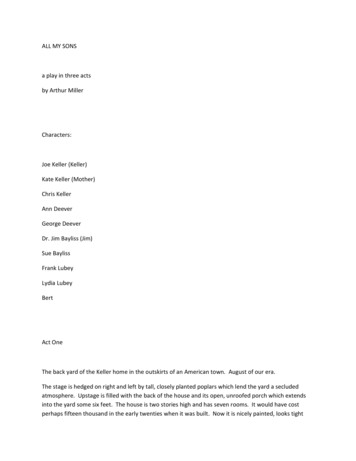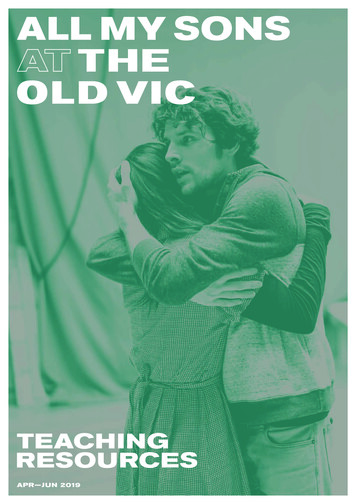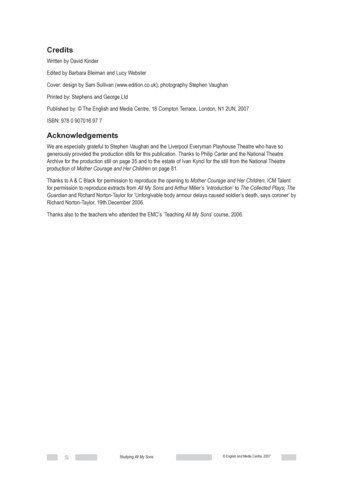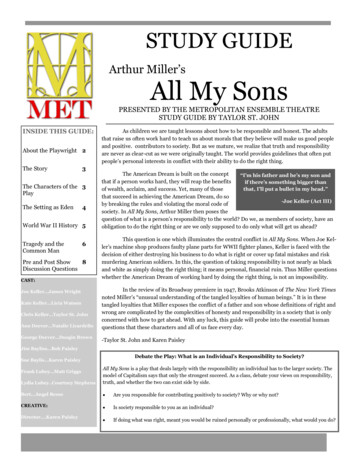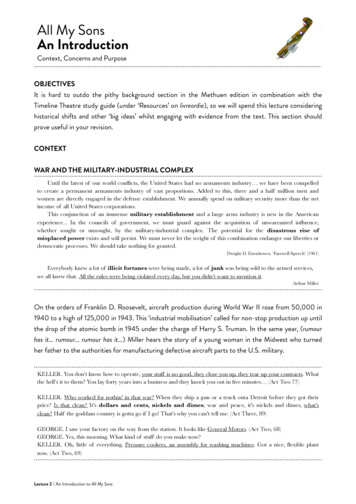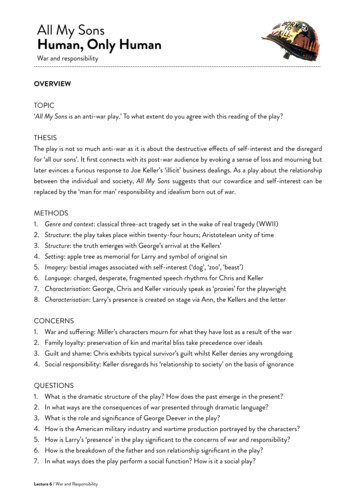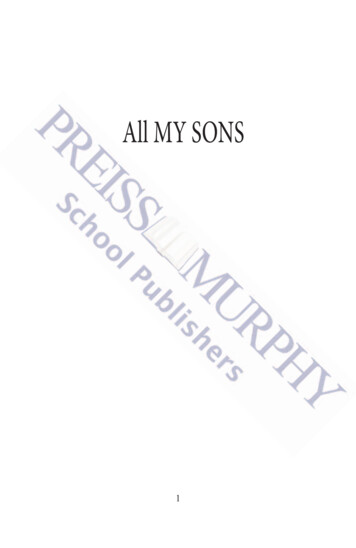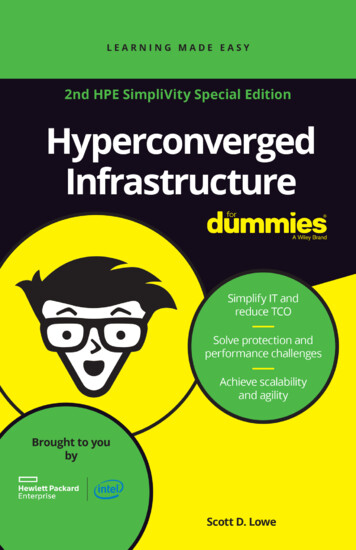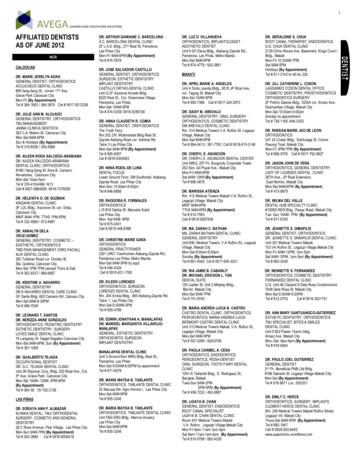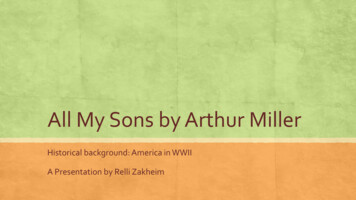
Transcription
All My Sons by Arthur MillerHistorical background: America in WWIIA Presentation by Relli Zakheim
America after the Great Depression In 1940, after 10 years of Depression, 9million workers were out of work. Vast reservoirs of physical productivecapacity also lay unused, including factories,heavy construction equipment, machinetool stocks, electrical generating plants,trucks, locomotives, and railcars. As much as 50% of capacity stood idle inautomobile manufacturing plants alone.(Freedom From Fear, Chapter 18 “The War ofMachines”, p617)
December 6, 1941: Pearl HarborThe Japanese attack the American fleetin HawaiiIn 1942 America declares war to theAxe powers and Joins the GrandAllianceIn January 1942 Roosevelt told Congress:“The superiority of the United Nations inmunitions and ships must be overwhelming acrushing superiority of equipment in any theaterof the world war”(Freedom From Fear, Chapter 18 “The War ofMachines”, p. 618)
The Selective Service System(Frank “was always one year ahead of the draft. When they were calling boys twenty-seven Frank was justtwenty-eight, when they made it twenty-eight he was just twenty-nine”) AMS, Act II, p. 79The Draft SystemIn 1940 the Selective Service Act had registered some 16million men between the ages of 21 to 36.Between 1940-1942 the age was extended from 18 to65. However, the military wanted no men over 45 andstrongly preferred to take only those under the age of26. Contrary to much later mythology, the nation’syoung men did not step forward in unison to answer thetrumpet’s call.The blacks represented 10.6% of the population butconstituted less than 6% of the armed forces at thebeginning of 1943.Fathers and married men were untouchable down toearly/end 1944.(Freedom From Fear, Chapter 18 “The War of Machines”,p632-33)
America: A consumer’s paradise1944 and after: The AmericanDreamIn 1944, most Americans have never had it so good: They started half a million businesses. They went to movies and restaurants. They bought books, recordings, cosmetics,pharmaceuticals, jewelry and liquor in recordvolumes. House-wives shopped at well-stocked supermarkets,11,000 of them newly built during the war.(Freedom From Fear, Chapter 21 “The Cauldron of theHome Front”)
How did the societal values change further toWWII?An American family in 1942The importance of the FAMILY Americans emphasized more strongly the primacy offamily and children in their lives than in previous eras.The marriage rate, which dipped in the Depressionyears, rose rapidly in the war decade. In 1942 itreached the highest level since 1920. By war’s end, a higher proportion of American womenwere married than at any time in the century, andwomen’s median age at marriage has dipped to anhistoric low. In the immediate postwar years, the average numberof children per household climbed from 2 to 3, as“Rosie” and her sisters abandoned work to becomethe mothers of the baby-boom generation, whosestatistical origin actually dates from 1940.(Freedom From Fear, Chapter 21 “The Cauldron of the HomeFront”)
WAR, CAMARADERIE and RESPONSIBILITY Benjamin Bradlee, later editor of the WashingtonPost, spoke for many veterans when heremembered the war as“more exciting, more meaningful than anything Ihave ever done loved the camaraderie theresponsibility. The first time a man goes into battle, isstrangely like the first time a man makes love with awoman. The anticipation is overpowering; theignorance is obstructive; the fear of disgrace isconsuming; and survival is triumphant.” WWII took men away from home, formedBattle of Okinawafriendships, and shaped the arc of their lives everafter.(Freedom From Fear, Chapter 20 “The battle for Northwest Europe”, p.712-13)
The disappointment of the veterans sent back homeat the attitude of the American populationOur own mail came up to us in canvas bags, usually with the ammo and rations. On several occasions I actually had tobend over my letters and read as rapidly as possible to shield them from the torrents of rain before the ink was smearedacross the soggy paper and the writing became illegible. Most of us received letters from family and civilian friends. Butoccasionally we received letters from old Company K buddies who had returned to the States. Their early lettersexpressed relief over being back with family or with “wine, women, and song.” But later the letters often becamedisturbingly bitter and filled with disillusionment. Some expressed a desire to return if they could get back into the oldbattalion. Considering the dangers and hardships those men had been through before they were sent home, andconsidering our situation in front of Shuri, the attitudes of our buddies who had returned Stateside puzzled us. Theyexpressed themselves in various ways, but the gist of their disillusionment was a feeling of alienation from everyone buttheir old comrades. Although there was gasoline and meat rationing back in the States, life was safe and easy. Plenty ofpeople were ready to buy a Marine combat veteran wearing campaign ribbons and battle stars a drink or a beer anytime.But all the good life and luxury didn’t seem to take the place of old friendships forged in combat.
There was talk of war profiteers and able-bodied men who got easy duty at the expense ofothers. Some letters said simply that folks back in the States “just don’t understand what thehell it’s all about, because they have had it so easy.” I heard more than one buddy express theopinion, as we sat in the mud, that civilians would “understand” if the Japanese or the Germansbombed an American city. Some men thought that would have been a good idea if no Americancivilians got killed, just scared. But nobody wanted it to be his hometown. It was hard to believethat some of our old friends who had wanted so much to return home actually were writing usthat they thought of volunteering again for overseas duty. (Some actually did.) They had hadenough of war, but they had greater difficulty adjusting to civilians or to comfortable Statesidemilitary posts.We were unable to understand their attitudes until we ourselves returned home and tried tocomprehend people who griped because America wasn’t perfect, or their coffee wasn’t hotenough, or they had to stand in line and wait for a train or bus. Our buddies who had gone backhad been greeted enthusiastically—as those of us who survived were received later on. But thefolks back home didn’t, and in retrospect couldn’t have been expected to, understand what wehad experienced, what in our minds seemed to set us apart forever from anyone who hadn’tbeen in combat.(Sledge, E.B. With the Old Breed (p. 268). Random House Publishing Group, 2007, Kindle Edition)
THE WAR OF MACHINES“Thanks to the dispensations of timing and geography, theUnited States could choose to fight a war of machines ratherthan men”. David M. Kennedy
The Commercial-to-military war production(George to Keller: “I saw your factory on the way from the station. It looks likeGeneral Motors”.) AMS, Act II, p. 82Ford’s Willow Run Plant in Detroit,which at its peak in 1944 produced oneB-24 an hour. In 1941 Ford’s plant in Detroit startsproducing B-24 bombers, followed byB-17 and B-29 “Superfortresses” thateventually delivered the two atomicbombs. General Motors led the largest warproduction effort in American history.In 1942, the company converted allfactories to produce 12 billion worthof airplanes, trucks, tanks, guns andshells for the military.(Freedom From Fear, Chapter 18 “The War ofMachines”, p. 652-53
America becomes the world’s super-powerAmerica in 1950 The engines of the military economyroared on, pounding on by the war’s enda fantastic statistical litany: 5,777 merchant ships; 1,556 naval vessels;299,293 aircraft; 634,569 jeeps; 88,410tanks; 11,000 chain saws; 2,383,311trucks; 6.5 million rifles; 40 billion bullets 2 atomic bombs(Freedom From Fear, Chapter 18 “The Warof Machines”)
AMERICA: THE WAR OF MENAnn: “I said he’s dead. I know! He crashed off the coast of ChinaNovember twenty-fifth! His engine didn’t fail him. But he died. Iknow ” AMS, Act III, p. 105
The Burma Campaign, 1941-1945(Mother: “ there was half a page about a man missing even longer than Larry and heturned up from Burma.”Chris: “You can have a helluva time in Burma.”) AMS, Act I, p 34 In 1941 a retired US Army Air Corps colonelClaire Chennault had begun recruitingAmerican pilots to help the Chinese in theirfight against the Japanese occupation. He organized a group of volunteer pilotsnamed AVG (American Volunteer Group),later called by the press the “Flying Tigers”because of the sharks’ teeth painted on thenoses of the P-40 aircraft they used to fly. The Americans fought along British andIndian forces.
Curtiss P-40 Warhawk One of WWIIs most famousfighters(Keller: “Larry never flew a P-40.”Chris: “So who flew those P-40s, pigs?”) AMS, Act I, p. 40 The Curtiss P-40 Warhawk is an Americansingle-engined, single-seat, allmetal fighter and ground-attack aircraft thatfirst flew in 1938. A total of 11,998 P-40s were built beforeproduction was finally terminated in 1944.Warhawks constituted the principalarmament of the U.S. Army Air Forces(USAAF) fighter squadrons throughout 1942and 1943. Even after the appearance of newertypes of fighter aircraft in the USAAFrendered the P-40 obsolete, it continued tocontribute to victory in a variety of Allied arhawk-one-of-ww-iis-most-famousfighters.htm
Curtiss P-40 in Australia(Keller: “The beast! I was the beast; the guy who sold cracked cylinders to the Army Air Force; the guywho made twenty-one P-40s’ crash in Australia.”) AMS, Act I, p. 38 By May 1941 Tomahawks werealso operating in the MiddleEast, eventually serving in thattheater with Australian andSouth African fightersquadrons as well as the RAF. In addition, the British sent 195Tomahawks to the SovietUnion after the Germansinvaded that country on June22, 1941.
BibliographyChaffe, William H.: UNFINISHED JOURNEY, America Since World War II, OxfordUniversity Press, Inc, Ny, 2015, 662pKennedy, David M.: FREEDOM FROM FEAR, The American People in Depression andWar, 1929-1945, Oxford University Press, Inc, NY, 1999, 936pMiller, Arthur.: All My Sons, Eric Cohen Books, 2010, 123pSledge, E.B.: With the Old Breed, (p. 268). Random House Publishing Group, 2007,Kindle Edition, 230p
All My Sons by Arthur Miller Historical background: America in WWII A Presentation by Relli Zakheim . America after the Great Depression In 1940, after 10 years of Depression, 9 million workers were out of work. Vast reservoirs of physical productive capacity also lay unused, including factories, heavy construction equipment, machine-tool stocks, electrical generating plants, trucks .
